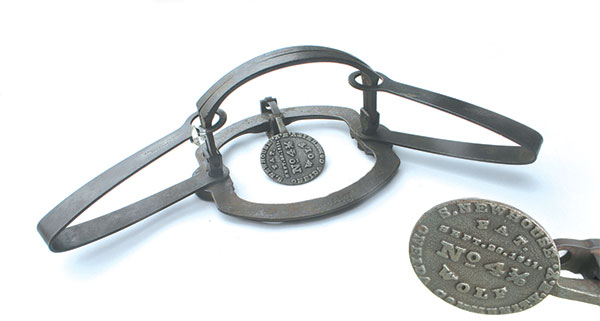 Antique Traps: Abbey & McLeod
Antique Traps: Abbey & McLeod
By Tom Parr

Fred Abbey and John McLeod of Lookout, Washington, were granted a patent for a trap with a cast round base and a detachable pan assembly. The October 5, 1897, patent reads:
In a trap, the combination of a support or bed having a clear opening in the center thereof, spring actuated jaws mounted on said support or bed, and an independent pan and trigger adapted to be applied to either side of said trap.
For a short time in the early 1900s, Oneida Community made the open-bottom traps with Newhouse springs, jaws and pans, in sizes No. 4, 14, 4-1/2, 5, and 15. There were three base assemblies: No. 4 and No. 14 with offset-jaws; No. 4-1/2; No. 5 and No. 15 offset-jaw version.
Most open-bottom traps are stamped Abbey & McLeod/Pat. on the flat upper surface of the round base while others only carry the size number on the undersurface of the base, near one of the jaw posts.
Apparently, a few prototype No. 6 traps also was made—for elephants. Though I don’t believe any ever were offered for sale, an Oneida Community journal states the following:
“About 1900-01 G.N. Allen in charge of export in Niagara Falls had an inquiry from a missionary in India or Burma through Montgomery Ward’s for a trap to catch tigers. The elephant trap idea came from the same missionary. We designed a trap with a circular bottom piece large enough for an elephant to put his foot through, probably to match a pair of 6 jaws. The cross piece, pan and dog was fitted to the side of the circular bottom, but not riveted to it. This was loose so that it would drop off when the trap was sprung. The plan for setting the elephant trap was to dig a hole in the ground, bridge it with sticks and set the trap on them and camouflage. The elephant’s leg would go through to the bottom of the hole and the trap would be well up his leg. OC also sent 6 or 8 samples of this trap to Africa …”
Abbey & McLeod traps with the detachable pan assemblies are a rare find, indeed, with no examples of the No. 6 known to exist. The No. 4 is most often found in antique trap collections.
Reproductions of the trap are being made in No. 4-1/2, 5, 15, and 6. The maker of this current-production trap does not offer it as an original, but beware. One might be sold as such by a dishonest or perhaps simply misinformed seller. An original Abbey & McLeod may fetch $4,000 or more in complete condition ,with the detachable pan assembly.
* * *
For information on this and other
collectible antique traps, contact:
Tom Parr, the North American Trap
Collectors Association, P.O. Box 94,
Galloway, OH 43119; (614) 878-6011.